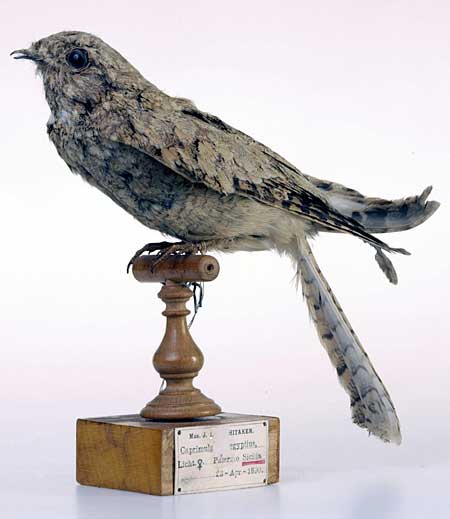
Caprimulgus aegyptius (*)
Superregnum: Eukaryota
Cladus: Unikonta
Cladus: Opisthokonta
Cladus: Holozoa
Regnum: Animalia
Subregnum: Eumetazoa
Cladus: Bilateria
Cladus: Nephrozoa
Superphylum: Deuterostomia
Phylum: Chordata
Subphylum: Vertebrata
Infraphylum: Gnathostomata
Megaclassis: Osteichthyes
Cladus: Sarcopterygii
Cladus: Rhipidistia
Cladus: Tetrapodomorpha
Cladus: Eotetrapodiformes
Cladus: Elpistostegalia
Superclassis: Tetrapoda
Cladus: Reptiliomorpha
Cladus: Amniota
Classis: Reptilia
Cladus: Eureptilia
Cladus: Romeriida
Subclassis: Diapsida
Cladus: Sauria
Infraclassis: Archosauromorpha
Cladus: Crurotarsi
Divisio: Archosauria
Cladus: Avemetatarsalia
Cladus: Ornithodira
Subtaxon: Dinosauromorpha
Cladus: Dinosauriformes
Cladus: Dracohors
Cladus: Dinosauria
Ordo: Saurischia
Cladus: Eusaurischia
Subordo: Theropoda
Cladus: Neotheropoda
Cladus: Averostra
Cladus: Tetanurae
Cladus: Avetheropoda
Cladus: Coelurosauria
Cladus: Tyrannoraptora
Cladus: Maniraptoromorpha
Cladus: Maniraptoriformes
Cladus: Maniraptora
Cladus: Pennaraptora
Cladus: Paraves
Cladus: Eumaniraptora
Cladus: Avialae
Infraclassis: Aves
Cladus: Euavialae
Cladus: Avebrevicauda
Cladus: Pygostylia
Cladus: Ornithothoraces
Cladus: Ornithuromorpha
Cladus: Carinatae
Parvclassis: Neornithes
Cohors: Neognathae
Cladus: Neoaves
Superordo: Caprimulgimorphae
Ordo: Caprimulgiformes
Familia: Caprimulgidae
Subfamilia: Caprimulginae
Genus: Caprimulgus
Species: Caprimulgus aegyptius
Subspecies: C. a. aegyptius - C. a. arenicolor - C. a. saharae
Name
Caprimulgus aegyptius Lichtenstein, 1823
References
Lichtenstein, M.H.C. 1823. Verzeichniss der Doubletten des zoologischen Museums der Königl. Universität zu Berlin nebst Beschreibung vieler bisher unbekannter Arten von Säugethieren, Vögeln, Amphibien und Fischen. 118 pp. Königl. Preuss. Akad. Wiss./ T. Trautwein, Berlin. Original description p.59 no.610 BHL DOI: 10.5962/bhl.title.40281 Reference page.
Vernacular names
čeština: Lelek světlý
Esperanto: Egipta kaprimulgo
Nederlands: Egyptische Nachtzwaluw
The Egyptian nightjar (Caprimulgus aegyptius) is a medium-small nightjar which occurs in south west Asia and north Africa and winters in tropical Africa. This is a fairly common species with a wide distribution which faces no obvious threats apart from habitat destruction, so the International Union for Conservation of Nature has rated its conservation status as being of "least concern".[1]
Etymology
The genus name Caprimulgus is derived from the Latin capra, "nanny goat", and mulgere, "to milk", referring to an old myth that nightjars suck milk from goats. The specific aegyptius is Latin for Egyptian.".[2] The common name "nightjar", first recorded in 1630, refers to the nocturnal habits of the bird, the second part of the name deriving from the distinctive churring song.[3]
Description
Resting during the day with chick
The variegated plumage is much paler than the European nightjar. The adult is sand-colours, barred and streaked with buff and brown. The under parts are sandy or whitish. It is smaller, but relatively longer-winged and longer-tailed than the more widespread species. Like other nightjars, it has a wide gape, long wings, soft downy plumage and nocturnal habits. The male has tiny white wing spots. The length is 25 cm, and the wingspan 55 cm. Its call is a repetitive mechanical kroo-kroo-kroo…, which rises and falls as the bird turns its head from side to side.[4]
Distribution and habitat
The Egyptian nightjar is native to northern Africa, the Arabian Peninsula and the Middle East. Its range includes Afghanistan, Algeria, Bahrain, Chad, Egypt, Iran, Iraq, Israel, Jordan, Kazakhstan, Kuwait, Libya, Mali, Mauritania, Morocco, Nigeria, Oman, Pakistan, Saudi Arabia, Senegal, South Sudan, Sudan, Tajikistan, Tunisia, Turkmenistan, United Arab Emirates, Uzbekistan and Yemen. It is a rare visitor to Europe, and has occurred as a vagrant in Denmark, Germany, Italy, Malta, Sweden and the United Kingdom.[1] Its typical habitat is open desert with a few scattered trees or bushes. It is often found near water in areas with sparse vegetation and scrub. Over-wintering birds in Sudan can be found in areas with long grass.[4]
Ecology
During the day, this crepuscular nightjar lies silent upon the ground, concealed by its plumage; it is difficult to detect, blending in with the sandy soil. It flies at dusk, most often at sundown, with an easy, silent moth-like flight; its strong and deliberate wingbeats alternate with sweeps and glides with motionless wings. Crepuscular insects, such as moths, are its food. No nest is made; the two elongated and elliptical eggs are placed upon the bare ground; the brooding bird, sitting closely, is their best protection. The population in northwestern Africa breeds in the desert and sandy steppe where there are areas with limestone outcrops, and overwinter in dry countryside with Artemisia, Tamarix and Salsola.[4]
Caprimulgus aegyptius distr.png
References
BirdLife International (2019). "Caprimulgus aegyptius". IUCN Red List of Threatened Species. 2019: e.T22689902A155483722. doi:10.2305/IUCN.UK.2019-3.RLTS.T22689902A155483722.en. Retrieved 13 November 2021.
Jobling, James A (2010). The Helm Dictionary of Scientific Bird Names. London: Christopher Helm. pp. 33, 90. ISBN 978-1-4081-2501-4.
"Nightjar". Oxford English Dictionary (Online ed.). Oxford University Press. (Subscription or participating institution membership required.)
Nigel Cleere (2010). Nightjars: A Guide to Nightjars and related birds. Bloomsbury Publishing. pp. 249–250. ISBN 978-1-4081-3547-1.
Retrieved from "http://en.wikipedia.org/"
All text is available under the terms of the GNU Free Documentation License

